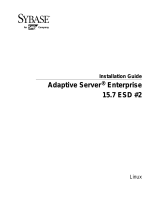
Page 6 Configuration and Tuning of Sybase System 11 for NetWare on Compaq Servers
1996 Compaq Computer Corporation, All Rights Reserved Doc No 140A/0896
Write Cache
When the Array Accelerator performs write caching, the drive controller writes data to the cache
memory on the Array Accelerator rather than directly to the drives. The system can access this
cache memory more than 100 times faster than accessing disk storage. The controller writes the
data in the Array Accelerator to the drive at a later time, when the controller is otherwise idle.
Without the Array Accelerator’s write cache, the application must wait until each write request is
written out to the disk. Writing to a disk device is slower than posting the write request in the
Array Accelerator, thus possibly resulting in decreased performance.
Read Cache
The SMART-2 controller uses the Array Accelerator to increase performance in some cases by
anticipating possible future read requests. The Array Accelerator uses a multi-threaded
algorithm to predict the next likely read operation for the drive array. That data is pre-read into
the cache on the Array Accelerator and therefore is ready before you access it. When the
SMART-2 controller receives a read request for the cached data, it can be burst read immediately
into system memory, thus avoiding a disk access after the read request.
The read-ahead option of the SMART-2 SCSI Array controller can boost performance in
environments that utilize sequential scans of data; for example, range lookups, data loads, table
scans, etc. Environments with a very random I/O profile, such as on-line transaction processing,
typically do not take advantage of the read-ahead capabilities of the controller, and in most cases
it is beneficial to configure 100% of the Array Accelerator for write caching.
Housekeeper, Checkpoints, and Transaction Log Writes
There are three main write-intensive operations Sybase SQL Server performs: housekeeper,
checkpoints, and transaction log writes.
During idle time on the SQL Server, the housekeeper writes dirty pages from the data cache
to the disk at a lower priority than the checkpoint process. Unlike a checkpoint process
which must write all dirty pages from the data cache to disk before terminating, the
housekeeper writes only what it can during idle times of the system. If the system is idle for
a long enough period of time the housekeeper may actually write all dirty pages from the
data cache to disk. When this occurs the housekeeper notifies the checkpoint process and
requests that a checkpoint be performed on the database so that the transaction log will have
a record that all dirty pages were written to disk at that time. (For details on configuring the
housekeeper, see Housekeeper Free Write Percent later in this document.)
During checkpoints, Sybase SQL Server generates a large number of write requests in a
short time interval. The main objective of the checkpoint is to write all dirty pages from the
data cache to the disk. The time it takes to write the dirty pages depends on several factors,
such as the configuration of the housekeeper and the recovery interval of the SQL Server.
(See the explanation of recovery interval later in this document.)
In some environments, the amount of write activity that the checkpoint generates can
saturate the Array Accelerator, thus interfering with read requests pending at the controller.
Proper tuning of the housekeeper can help alleviate this problem.
The transaction log activity is composed exclusively of sequential writes and does not
saturate the Array Accelerator. However, the benefits of caching the transaction log writes at
the SMART or SMART-2 SCSI Array Controller level with the Array Accelerator can have
a significant beneficial impact on performance. For optimal performance the Array
Accelerator should be enabled. It is very important to make sure you follow the guidelines
below for data integrity if you choose to enable the Array Accelerator on the transaction log.





















